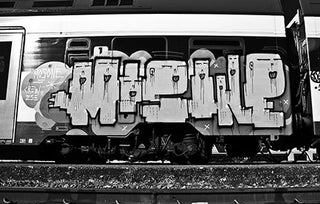When Mosone began his career as a trainwriter, I was still in elementary school completely unaware of the existence of this phenomenon. Then, of course, I grew up – and noticed the graffiti on the trains. I ended up going to university and decided to document them. Actually, my goal initially was to learn how to draw those same letters, but I’ve never tried to do it, and since I had accumulated tons of pictures on my cellphone, in January 2010, I decided to open a Tumblr where I posted daily flicks of the graf scene in Italy.
After I moved to Milano, I started to see and photograph Mosone‘s very particular panels; quickly my curiosity grew towards him and I wanted to meet this guy. When it happened, I was really impressed by his kindness and inner calm – it was almost hard to believe he was the same artist who has hit Italian and European trains for more than 17 years. Chatting with him was very pleasant and I found our conversation essential to understanding his unique and original style. Mosone’s panels aren’t a matter of spray paint on a metal surface, what you see is a figurative type of lettering that he developed from deep research and from his particular observations of society and the people he meets.
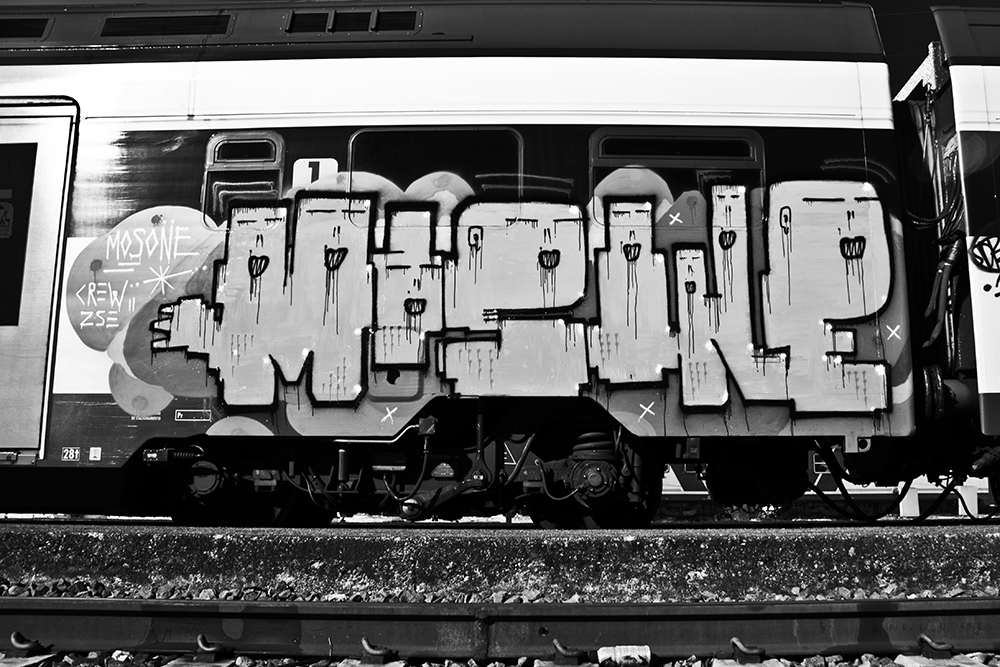
SPRAYTRAINS: What’s the first memory you have linked to trainwriting?
MOSONE: Snow and frost. I did my first panel when I was still a minor, seriously afraid that my parents would find out because I had to sneak out the house at 10 PM to be picked up by my friends who were older and had a car. This experience was very special to me. I waited for at least for a year and a half before, while practicing with at least 40 containers available to me in the yard of my hometown. We had a hard time getting in and out because we were just starting to discover this yard. It ended up with a beautiful picture of me in front of this panel surrounded by the snow.
Even before the first panel, how did you come in contact with the graffiti world?
The year was 1994 and as a child I made a trip to Rome, where I basically asked my parents what all those tags I saw everywhere were. My father explained to me that they belonged to the graffiti movement. He had some very special memories of Keith Haring and Basquiat and therefore knew a very different aspect of graffiti. My father thought that those marks belonged to the artistic trend of the post-American graffiti. I started painting in 1997 but 2 years earlier I was already training on paper; experiencing it with my sketchbook.
What does it mean to grow up doing graffiti?
I did not settle in the local scene of my town and I always had a gypsy attitude. I pretty much went everywhere with the trains, some days skipping classes since middle school, but mostly traveling on the weekends. I really saw all of Italy – from Sicily to the North. When I was a kid I wanted to discover new people and it was simple because often you met people with your same look: wide trousers, caps, and other small things. It was almost automatic to find an approach towards them. Then, a few years after I started painting I discovered Aelle1, and that in my town there were lots of other writers. I even discovered a subterranean hall in my town where the writers that had preceded me did it 6 years before, some big names where up there. Back then I met a guy much older than me who was a madman and was considered the most active train bomber in Italy, but I would not drop his name here. He made me go through some gnarly experiences and crazy stuff but at the same time taught me a lot of tricks.
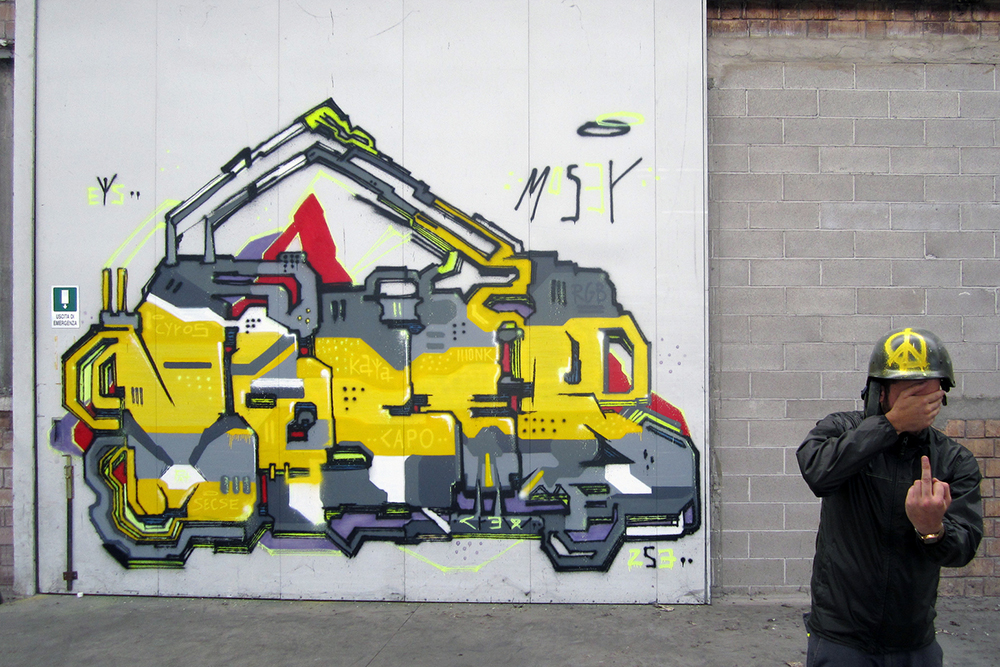
Tell me about your style.
I have always looked around myself and absorbed every visual stimulation coming from the city, the society, and the people I’ve met. I like to mix visual elements from the human being into the letters to obtain a figurative type of lettering a synthesis that I have been working on since mid-2000s.
I believed I was already and outsider of the phenomenon, only because I was detached by some categories or specific style currents. I didn’t belong to them and people had an hard time labeling me. I do not like labels. Most of the time I was marginalized by those who followed the classic style code just because I was trying to find my originality. Tipping the scales almost because of the phenomenon, and this thing penalized me for at least 5-6 years until I found a kind of style I could present to the public. Finally I was aware of what I was doing and realized that my approach wasn’t tied to past cultures. I was trying to find a formula to create new ones. I have a very intricate subjectivity, it’s often complex for me to handle human relationship.
Who has influenced you speaking at an artistic level?
All of the art and artists of the ‘90s, from the biggest to the small Italians, not so much the muralists ones but, directly, the contemporary art.
Tell us about a typical Italian-style action.
Our actions were based on semi-clandestine meetings over the weekends: the night would start with some drinking and some fun at a party or someone’s house. Then we would do at least 3 actions, a mellow one and two beautifully hardcore ones. After closing our panels we would empty all the remaining colors and, at sunrise, go for a lovely breakfast with cappuccino and croissant.
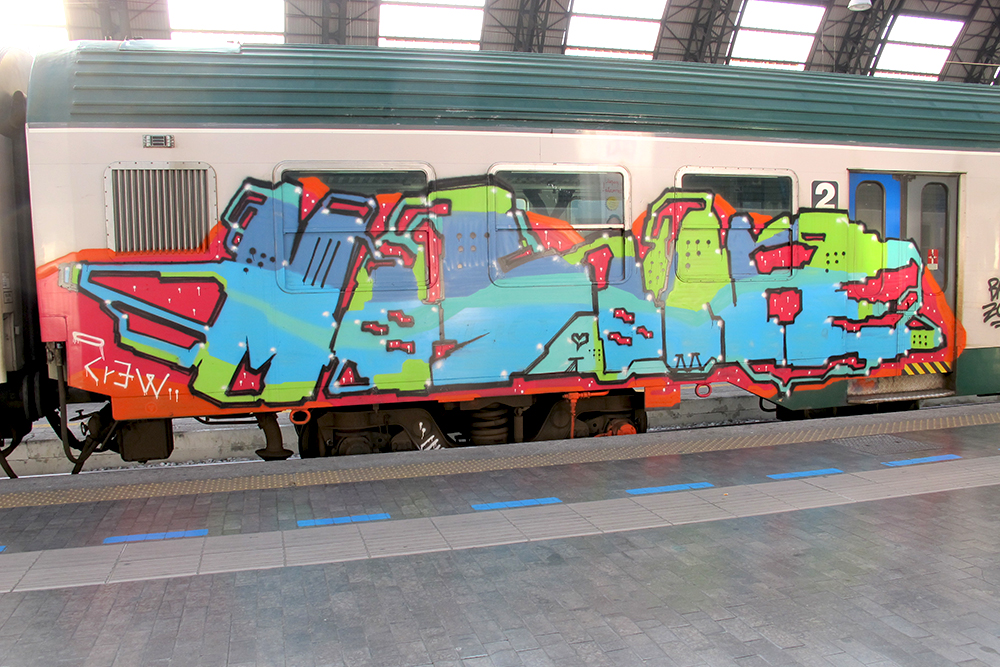
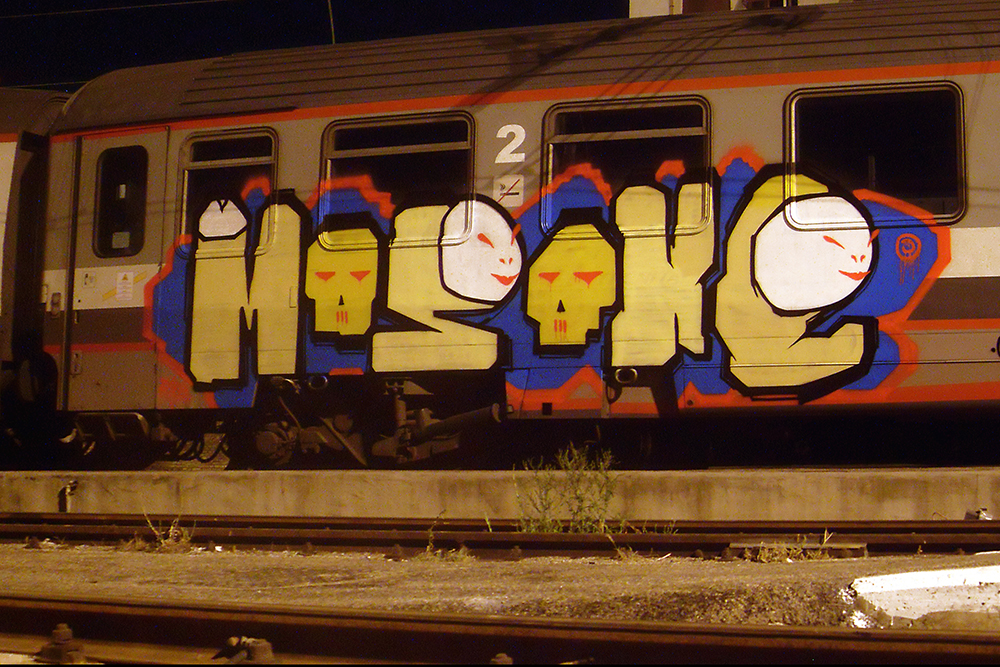
What’s it like to go painting abroad and how did you get in contact with foreign trainwriters?
The first place abroad I went was Austria and I was still very young. I didn’t have a contact so I went alone. I didn’t care, I was already very drawn to trainwriting so I felt the need to do so much and leave marks around and the panels where my preferred thing to do. A few years later I started to get in contact with the “tourist trainwriters” that would come to bomb Italian trains. The first ones were from Switzerland and we developed a strong bond. It was a time when I did many hall of fames during the day and even more panels at night.
Those things happened because there was a connection between all the disciplines, from DJs to breakdancers to graffiti writers. Then over the years the phenomenon of graffiti has become very European – almost worldwide – and we often exchanged codes between us and foreign writers, it was always very interesting.
Have you ever tried the other disciplines?
Yes, I did breakdancing for 4 years when I was young. I liked it a lot especially being all together and hanging out with people with my same passion. Now if I get too drunk I might start freestyling.
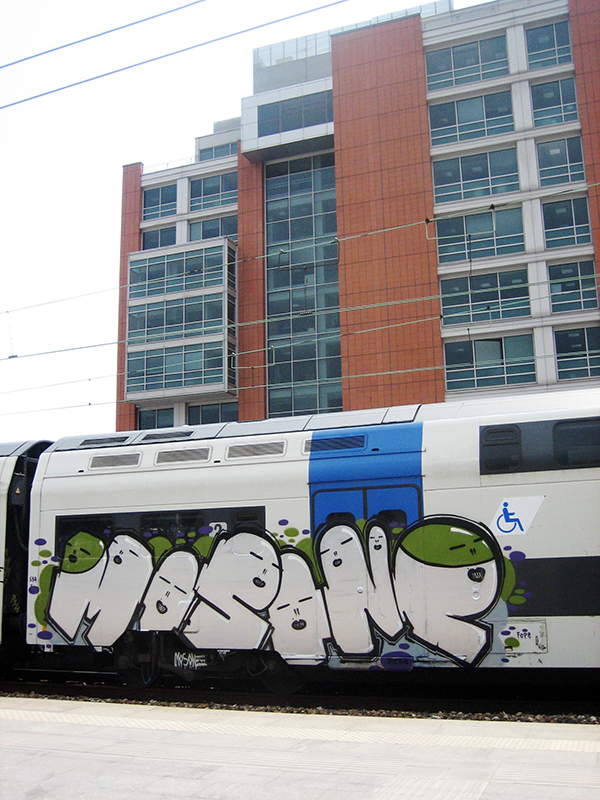
What is it like having such tight friendships and brotherhood in the graffiti world?
All of my friends are part of this phenomenon, and I am much closer to them than with my childhood friends. I know the brotherhood feeling really well because I am part of some crews that are like family to me. I can assure you that doing graffiti is a style of life that will give you a different view on some subjects. It takes you to complete and understand so many situations in life such as friendship and love and many other things. Graffiti, for me, has expanded my perception of any kind of social life that I have and have had over the years. It really gave me so much.
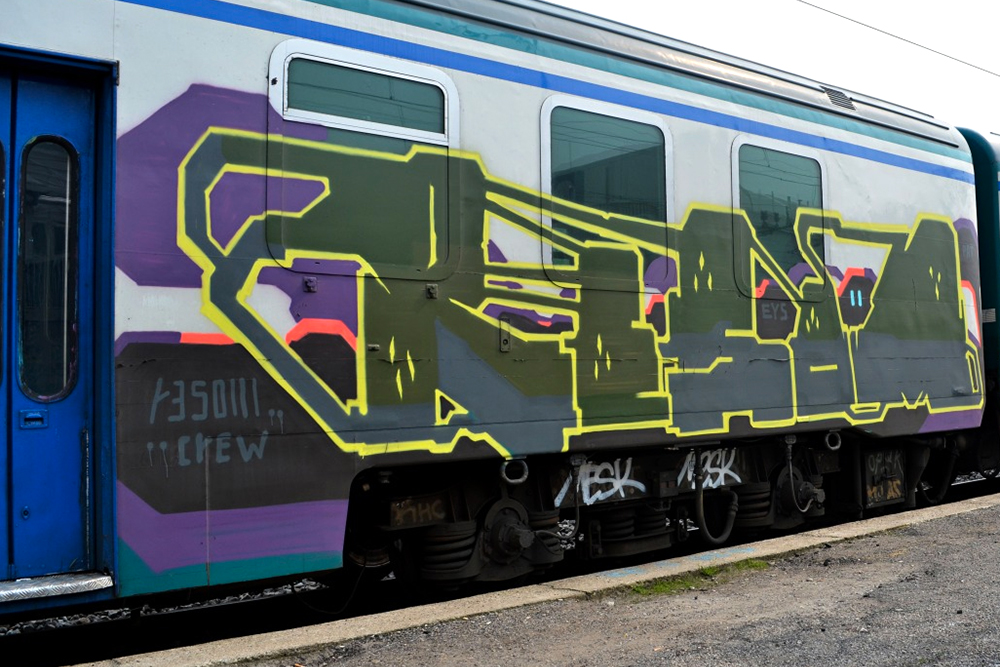
Have you ever argued with someone or been into fights for panels?
I have had several problems but I am a hyper peaceful person and I do not like these kind of things. Never liked ‘em. This is the downside of graffiti and I’ve always tried to avoid it. For me graffiti is a beautiful thing, those who see it as an aggressive thing is because they have it in their nature. To me, these are the kind of people that bring down the cultural level of the phenomenon itself. In my opinion graffiti is not art, it’s a way of life. Making graffiti is a lifestyle, I do not do it just to have visibility. For me it’s more a physical and inner need, if I don’t do them I kinda feel sick. I love to complete myself doing graffiti.
Is your mind 24/7 on graffiti or are you able to balance other things of your life?
Yes I can, but the mindset of being a writer definitely affects my daily life. Because I think and confront many situations with a view perhaps slightly deviated from the past experiences that I went through and that formed me.
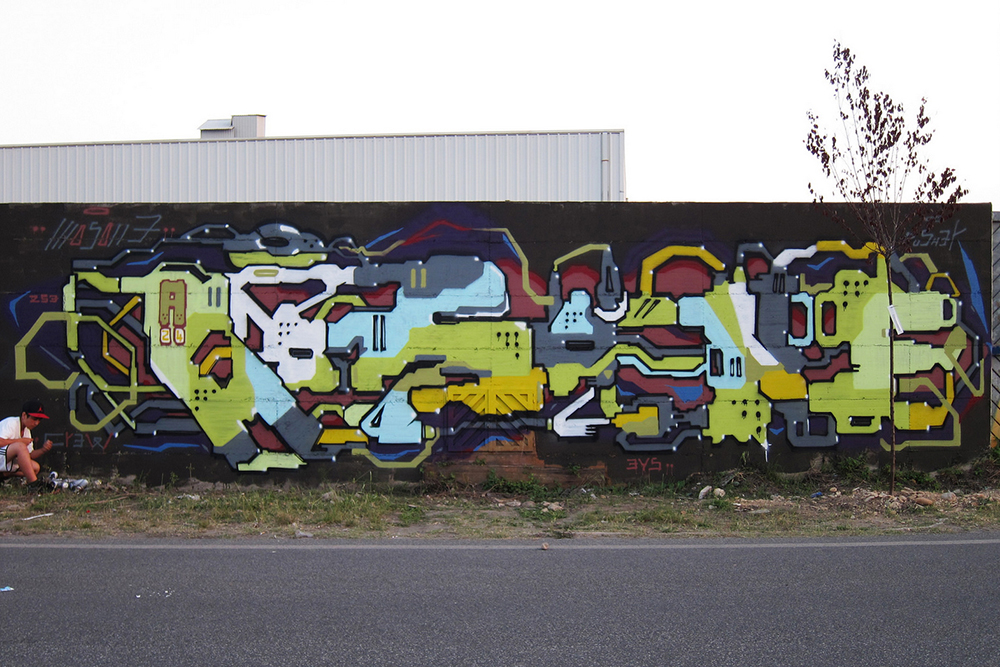
What do other people think of you? Did you ever care about their opinion?
I honestly don’t know. After so many years of doing graffiti I hope that what I’ve done in the past, and I still do, can be appreciated by new generations. I’ve certainly had a lot of satisfaction over the years, meeting up with guys that appreciated my type of work and gave me good feedback. I believe that my thing is very special since it’s not something copied or something that belongs to certain styles. Usually, I would getting recognized by the others thanks to my attitude, especially since I was not taking things that were very fashionable or be part of an already established current.
In my opinion, 85% of Italian graffiti writers have a xenophilous style – meaning that they are tracing what has already been done in New York or in France where there is a scene that’s actually alive and stylistically very fertile. I remember when I started, every writer needed to find their personal and unique style and pump it as much as possible. According to me, graffiti is about creating letters that are purely yours, that no one has ever done, and that will give a radical change to the aesthetic. This is a complexity that few of the new school are trying to make. I moved away from the phenomenon because I could not find people who have that predisposition to change. I see little originality n the Italian graffiti scene, lots of biting and only quantity and not quality.
Tell us about your crews and if there are differences between painting with Italian friends or foreign ones.
My relationship with the crews I’m in is always very positive because, as I said before, they are like a family to me. Going around like a gypsy allowed me to make contacts in every place I wandered. I’ve learned so much from my fellow friends, especially since I was in some of the most influential crews in Italy like M4C, which is from Perugia where I lived, ARF, from Rome, and the international crew Crew – just to cite you a couple. To me painting is the same because we have our own kind of language, the difference is that everyone has, within himself, the experiences he went through and each state has its own characteristic. For quite a while Italians were considered to be “less good” than others because we had easier yard to access and paint over. Now things are changing, slowly, probably mostly thanks to the Internet and the easy access to materials to get inspiration.
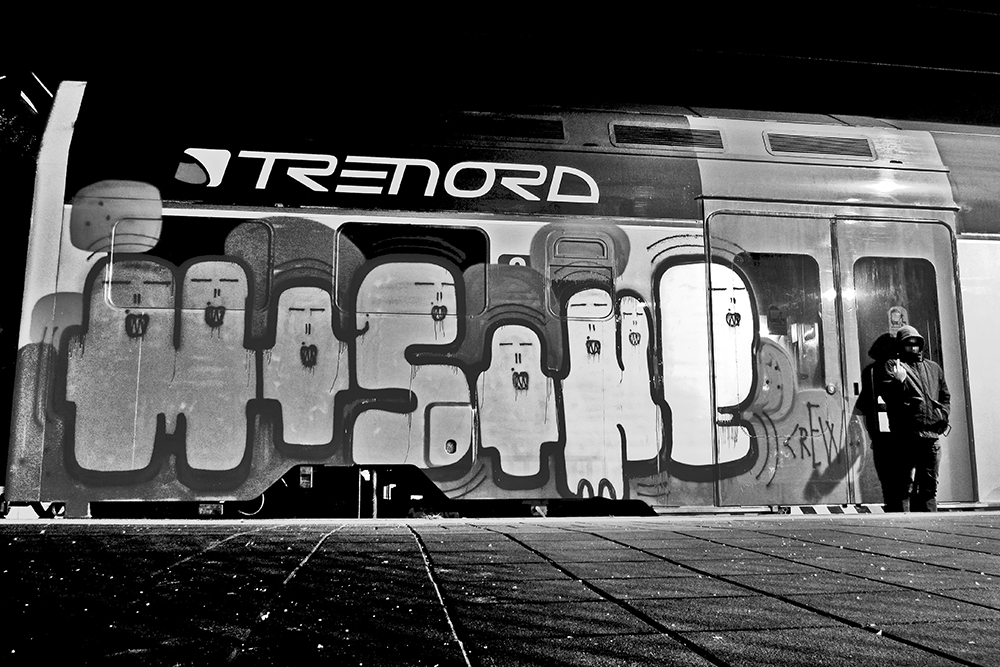
What do you think about graffiti on the Internet?
I believe the Internet has facilitated the spread of this culture and definitely has eradicated what was once a hidden code that was much less understandable.
Do you have all the flicks of your panels?
No, I miss a lot of ‘em. Before from ’97 to ’06 I used to print at least one roll of 36 photos every week. With the digital camera I started to loose track and now I don’t have anymore proper documentation. Since 2006 I don’t have a photo book.
Did you do a lot of tagging, throw-ups, and street graffiti?
Not so many throw-ups because I was more dedicated to making panels and I did a little of street. For me, tagging and street graffiti wasn’t what I wanted to do, I started with panels and I’ve stuck with them.
Do you believe it’s important for each artist to improve and try different styles and techniques?
Absolutely – diversify, study, and experience isn’t something that everyone does. Many are satisfied with the position they arrive – with a style that is understood and loved by all. I do not settle. I like to change, to study, and generate new forms; new letters. I like a more instinctive type of graffiti writing with a lot of research at the starting point.
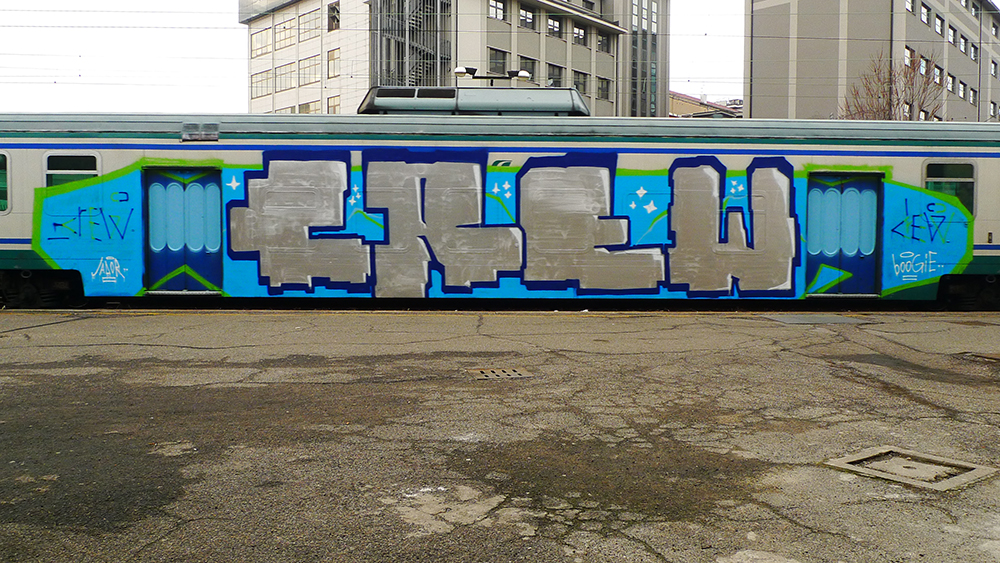
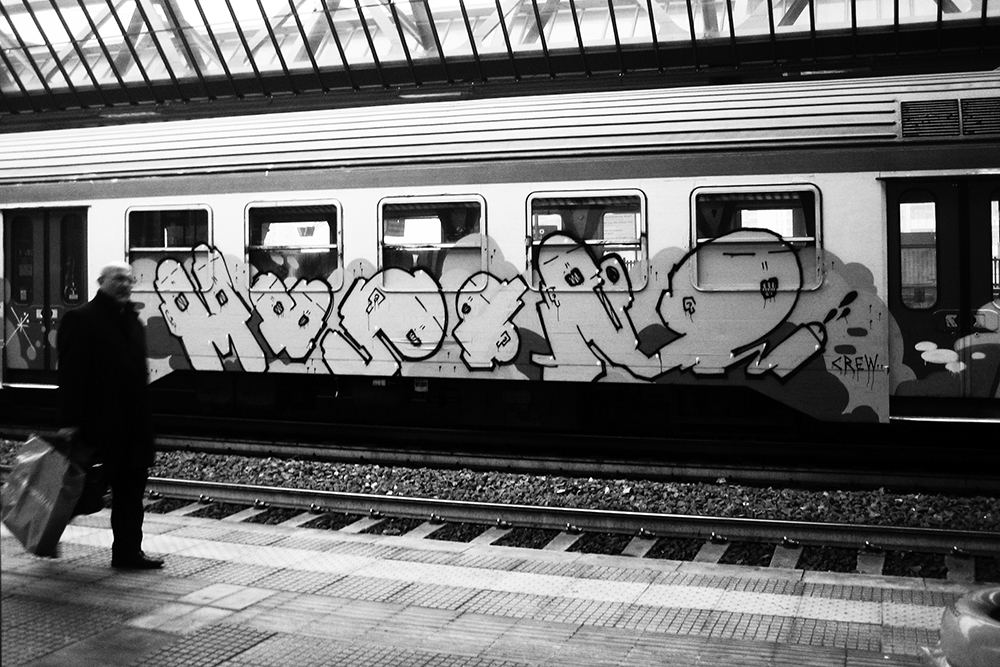
Is there an piece that you will remember for a lifetime?
I swear I remember them all and this is the most beautiful thing. Even if I missed the maniac phase of the documentation, I remember every single one I did, from the first to the last one. I remember the smells, the sounds the feelings that I felt in those moments, when I successfully closed my piece or when I had to run for my life. These are the things that differentiate you from those who do graffiti just to get an external visibility. My goal is to improve myself personally. And this is something that few people care about but for me and my brothers it’s vital. The personal memory for me is the most remarkable thing of graffiti and the experiences you’ve had with people important to you in your growth process. Every now and then I try to image myself as on old man and I wonder if I will have the strength to continue or not and only have these memories. But I believe I will continue because I just cannot stop doing this. Firstly, because I don’t want to, and secondly, as I said before, doing graffiti is something visceral. I was born with this stuff and I will try to bring it forward as possible.
Do you ever think you inspire someone with what you do?
I hope I am able to inspire the people that are at the train station waiting for their trains – or at least have them to look at something different! Doing graffiti means also passing down your own style, self expression... And I am a person who tries to pass on what I’ve done, but only to those people that are sensitive and that have values in their lives. For those who do it without values or passion, they will be easily forgotten in a short time. And those are the same people that are sullying what I think is a surprisingly strong culture.
Greetings.
For all my brothers, my crew brothers, and those people who affected me in these years and share my same passion.
::
Check out more of Mosone’s work tagged on Tumblr.

